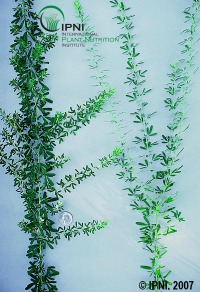Sericea Lespedeza
Adaptation
- Entire state. Very tolerant of drought, low fertility and acid soils.
Establishment
Plant 15 to 20 lb/A with cultipacker-seeder on prepared seedbed during late March to May. Herbicide essential as seedlings are slow growing.
Varieties
AU Grazer is recommended for grazing and hay production. Other available varieties may achieve successful results, but have not been researched well enough to be recommended.
In-Depth
 Sericea lespedeza is a long-lived, deep-rooted, drought resistant perennial that will grow on heavy, well-drained soils throughout the state. It grows erect, with stems 2 – 4 ft tall and can be used for grazing, hay, or soil conservation. Sericea is frequently used for cover on road banks to prevent erosion. Sericea can be grown on soils too acidic and infertile to support other forage legumes. However, it will not be very productive unless it is well fertilized.
Sericea lespedeza is a long-lived, deep-rooted, drought resistant perennial that will grow on heavy, well-drained soils throughout the state. It grows erect, with stems 2 – 4 ft tall and can be used for grazing, hay, or soil conservation. Sericea is frequently used for cover on road banks to prevent erosion. Sericea can be grown on soils too acidic and infertile to support other forage legumes. However, it will not be very productive unless it is well fertilized.
Sericea can provide moderate quality forage. However, as the stems get taller and the plant matures, the stems become highly lignified and very woody. As a result, late maturity will result in very poor forage quality and most animals will increasingly avoid areas of mature sericea. Therefore, sericea should be managed in such a way as to keep the plants growing vigorously. Grazing should begin when plants are 8 – 15 inches tall and should not be grazed closer than 4 inches. Hay harvests should be taken when plants reach 15 – 24 inches of height. Sericea provides good quality forage in summer when dry weather has reduced the growth of other forage crops.
Sericea lespedeza also contains high concentrations of condensed tannins. High levels of these tannins will reduce forage digestibility. However, research at Fort Valley State University has shown that these tannins can act as an anthelmintic (dewormer) to help control parasitic worms in small ruminants (e.g., goats, sheep). The use of sericea for this purpose holds significant promise as producers seek ways to reduce the buildup of anthelmintic-resistant populations of internal parasites. Low-tannin varieties of sericea lespedeza are also available, and these are more palatable than high-tannin varieties.
Sericea lespedeza can be seeded on a prepared seedbed in the spring as soon as the last spring frost has passed. A cultipacker-seeder should be used to seed 15 – 20 lbs of inoculated, hulled, scarified seed per acre. Sericea stands are slow to establish, so it is essential to apply a pre-plant incorporated herbicide. Do not cover the seed with more than ¼ in. of soil. Generally, sericea should not be grazed or cut for hay in the establishment year unless weather conditions have been excellent, resulting in rapid growth.
Dr. Dennis Hancock
Forage Extension Specialist
Crop & Soil Sciences Dept.
